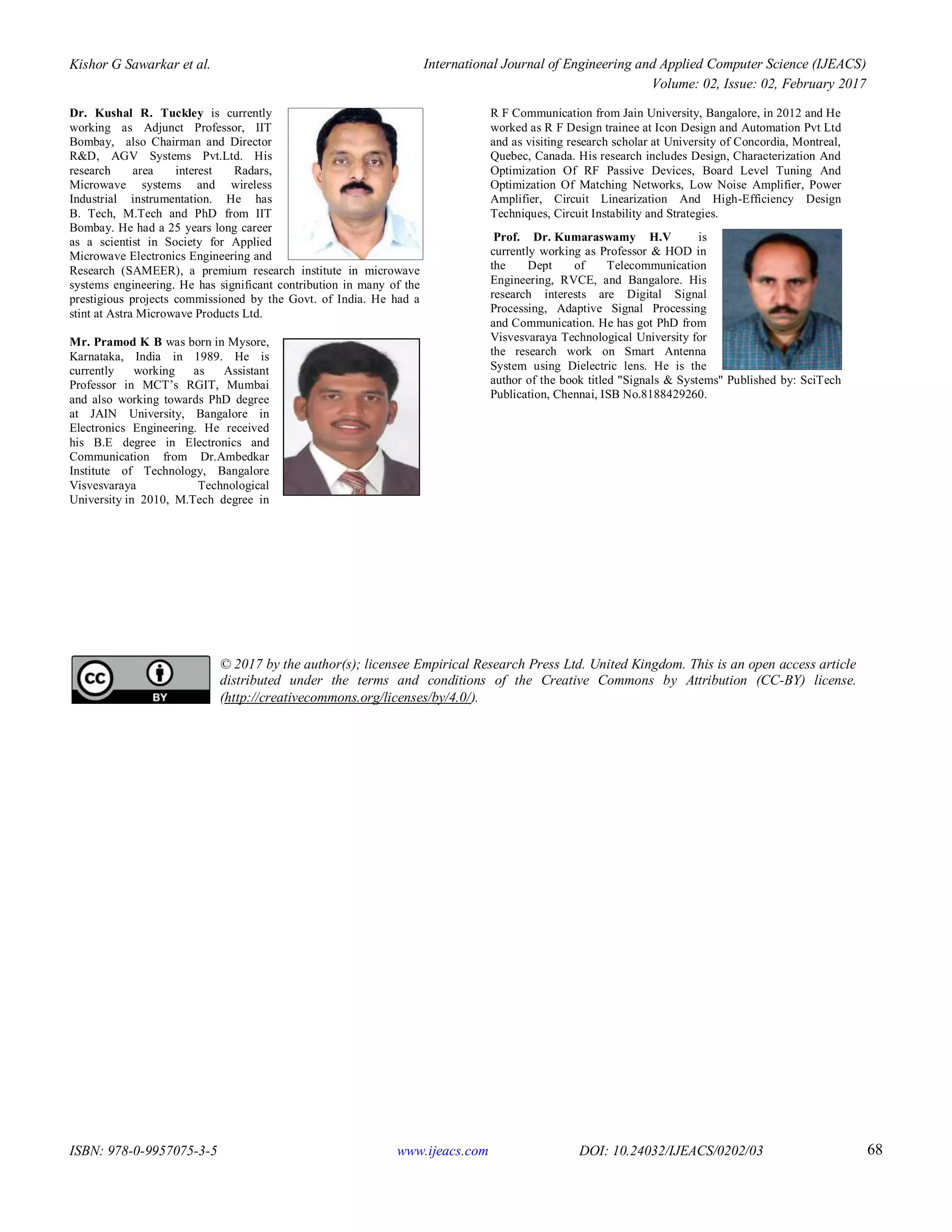The document discusses the influence of biasing circuits on the performance of ultra-wideband low noise amplifiers (LNAs) operating between 3 GHz to 10 GHz. It emphasizes the challenges of biasing design, including optimization methods and various bias circuit configurations, and presents simulation results that showcase the impact of different biasing approaches on key performance parameters such as gain, noise figure, and return loss. The paper also details several cases with different biasing schemes and their outcomes to inform design practices in microwave applications.
![International Journal of Engineering and Applied Computer Science (IJEACS)
Volume: 02, Issue: 02, February 2017
ISBN: 978-0-9957075-3-5 www.ijeacs.com DOI: 10.24032/IJEACS/0202/03 60
The Approach on Influence of Biasing Circuit in
Wideband Low Noise Amplifier to Evaluate
Robustness Performance
Kishor G Sawarkar 1
, Kushal Tuckley2
Pramod K B 3
, Kumaraswamy H.V 4
1
Research Scholar at MCT’s RGIT
2
Adjunct Professor at IIT, Bombay
1,2
Mumbai, Maharastra, India
3
Ph.D. Student of Jain University
3
Assistant Professor at MCT’s RGIT
4
Department of Telecommunication
4
R. V. College of Engineering, Bangalore, India
Abstract—This proposed work investigates the effects of biasing
circuit in the ultra-wideband microwave low noise amplifier
which operates between 3GHz to 10GHz. The complete circuit is
visualized the importance of every component in the design with
respect to linear measurements like Gain, Noise Figure, Return
loss under unconditionally stable condition. The design and
realization are made by using Hybrid Microwave integrated
circuit in AWR microwave office. The thing that is absolutely
necessary and frequently the difficult step in the design of an
LNA is 'biasing circuit design'. The difficulty situation arises
because traditional methods LNA by using S-parameters data
files in EDA tools provides almost all linear measurements.
Hence a number of time consuming iterations of different biasing
circuits with optimization methods may be required to reach
targeted specifications with the fixed operating point at the
desired points in the load line. Considering this behavior, various
alternate biasing circuit schemes are prepared and founded the
results associated with it. Furthermore, this paper unmistakably
clarifies the impacts of the biasing circuit by utilizing
intermodulation and harmonics distortion technique for
portrayal characterization. Different cases and sorts of the
biasing circuits with various biasing focuses have been tested and
given clear perspective of the biasing ideas.
Keywords- PHEMT, Biasing Networks, AWR microwave office,
Impedance matching, HMIC and LNA
I. INTRODUCTION
Advancing in the wireless communication networks it has
been arise the set of circumstances found that design of
Microwave circuits should meet various parameters at a time
with good performance. In case of LNA the parameters like
Bandwidth, Gain, Noise figure and return loss should all meet
the specifications at the same time eventually all those
parameters with not work with each other favors. To meet at
the specifications with the help of theoretical equations and
majorly the tuners in the commercial software EDA tools like
AWR Microwave office, ADS, HFSS etc. are made quite easier
for microwave circuit designing.
[5] In contrast, hybrid MIC circuits using discrete
components and distributed elements occupy more area and
dissipate more power. However, hybrid MIC technologies
provide a shorter design time, capabilities of customization and
fine tune of fabricated circuits. Also, Optimization of the
variables becomes quite easy.
In this paper, authors present effects of biasing in the LNA
which includes design optimization and analysis of matching
networks and various bias circuits and variation of their effects
in primary circuit are explained. [6] To satisfy high gain, LNA
is designed by using cascade topology and to achieve
maximum power transfer, impedance matching is essential for
proper gain and NF with VSWR. Some of network to build
impedance matching uses lump element, micro strip line or
combination of such elements. Many design of LNA have been
conducted and proposed to satisfy high gain and good
impedances matching network using lump element or micro
strip line and some of characteristic design has been obtained at
the defined frequency and application. For all circuit design the
industrial standard AWR microwave office tool is used, also to
optimize micro strip line and impedance matching to determine
trade off value of gain, Noise Figure, return loss and voltage
standing wave ratio (VSWR).
This paper is organized as follows. The research
background which is composed of recently published articles
with respect to biasing circuits in microwave is described in
Section II, the design of the low-noise amplifier with different
bias circuit is presented in Section III, the LNA performance
under limited set exposures with results are discussed in
Section IV and finally the conclusive remarks are drawn in the
last section.
II. RESEARCH BACKGROUND
This segment examines distributed data about biasing
circuit in microwave circuits, additionally, their estimations
techniques and investigation. [7] In their work, presented a
balun low noise amplifier (LNA) in which the noise figure
(NF) and power consumption are reduced by using a feedback](https://image.slidesharecdn.com/the-approach-on-influence-of-biasing-circuit-kishor-g-sawarkar-170301141551/75/The-Approach-on-Influence-of-Biasing-Circuit-in-Wideband-Low-Noise-Amplifier-to-Evaluate-Robustness-Performance-1-2048.jpg)
![Kishor G Sawarkar et al. International Journal of Engineering and Applied Computer Science (IJEACS)
Volume: 02, Issue: 02, February 2017
ISBN: 978-0-9957075-3-5 www.ijeacs.com DOI: 10.24032/IJEACS/0202/03 61
biasing structure. The circuit was based on a conventional
wideband balun LNA with noise cancellation. In which they
replaced the typical current source of the CG stage by a
transistor that established a feedback loop in that stage. [8]
introduced linearity change of a 10 W GaN HEMT PA utilizing
a dynamic entryway biasing procedure for smoothing an
exchange period of the PA as indicated by the quick
information power. Zhang, Ma, Yu, & Li, [9], exhibited a
dynamic biasing circuit was inserted in the chip which
mitigates the deviation of biasing point, enhances the solidness
and consistency of execution. Both noise and small signal
measurements are performed on-wafer. Ghosh & Srivastava,
[10] , gave the symmetric design biasing system, which makes
the structure polarization uncaring not at all like which was
accounted for active frequency-selective surface(AFSS).
Harzheim, Heuermann, & M. Marso,[11], displayed a versatile
biasing strategy for step recuperation diode based brush
generators which was controlled by a product schedule. The
point was to give the most extreme conceivable consonant
yield power for a given arrangement and diverse information
frequencies amid info power variety.
A. Hypothesis behind the Biasing Circuits
With the thought of practical bias ways for inclination of
transistors. Contrasted with design practice at lower
frequencies, fitting biasing expressions are more constrained
RF and microwave since it is hard to keep the biasing circuit's
parasitic from connecting with the signal path way at
microwave frequencies [12-14].
B. Bias Circuits and its Instabilities
Once the microwave LNA is composed, it stays to give the
dc bias voltages and currents required for the dynamic active
device. This is no straightforward issue, as the courses of action
to present the biases can aggravate the microwave circuit. By
and large, high impedance miniaturized micro strip follows can
be utilized as decoupling inductors, yet alert must be practiced
not to make a low frequency oscillator circuit in the
predisposition bias network system.
A typical reason for inconvenience is the utilization of an
inductor with a huge bypass capacitor, which can make a
resonator in the GHz region that can bolster oscillation of the
active components, which will have high gain at lower
frequencies.
Bias-circuit instabilities are a common source of problems
in amplifiers and other active circuits. These for the most part
result from the utilization of inductors and capacitors in the
Bias-circuit without respect to resonances or circumstances
where 180° stage movement can happen.
III. LNA DESIGN AND ANALYSIS
LNA parameters are mainly depend on S parameters which
varies with respect to frequency. Also Гin depends on Zin and
ГL, ГL depends on ZL and ГIN . Zin and ZL will be different for
different biasing components. Effects of biasing components is
also frequency dependent.
Figure 1. The small signal model of a pHEMT
Cgs and Cgd depends on the biasing voltage because the
depletion region changes with the bias .
Figure 2. The small signal model of a pHEMT at zero drain bias and gate
voltage below pinch-off
The three capacitances Cg, Cs and Cd are given by triangle-
star transformation as given below
Cg = Cgs + Cgd + [(Cgs* Cgd)/ Cds] (1)
Cs = Cgs + Cds + [(Cgs* Cds)/ Cgd] (2)
Cd = Cds + Cgd + [(Cgd* Cds)/ Cgs] (3)
Input port and output port impedances can be expressed
using
Z11 = Rg +Rs + j * [ꙍ( Lg + Ls) – (1/ ꙍ) { ( 1/Cg )+ (1/Cs)}] (4)
Z22 = Rd +Rs + j * [ꙍ( Ld + Ls) – (1/ ꙍ) { ( 1/Cd )+ (1/Cs)}] (5)
Input reflection coefficient and output reflection coefficient
Γin = ( Zin – Z0 )/( Zin + Z0 ) (6)
ΓL = ( ZL – Z0 )/( ZL + Z0 ) (7)
Equivalent input and output impedances can be expressed
in terms of two port Z parameters.
Zin = Z11 – [(Z12* Z21)/( ZL + Z22 )] (8)
ZL = Z22 – [(Z12* Z21)/( ZG + Z11 )] (9)
On the premise of the above arrangement numerical
conditions unmistakably reliance of Γin and ΓL furthermore
Zin and ZL on Cg, Cs and Cd which changes because of
progress in biasing conditions.
A. Case 1: With Ideal Bias
Case 1 which incorporates the circuit schematic in figure 3
arranged by using the S-Parameters .S2P documents or mdiff](https://image.slidesharecdn.com/the-approach-on-influence-of-biasing-circuit-kishor-g-sawarkar-170301141551/75/The-Approach-on-Influence-of-Biasing-Circuit-in-Wideband-Low-Noise-Amplifier-to-Evaluate-Robustness-Performance-2-2048.jpg)
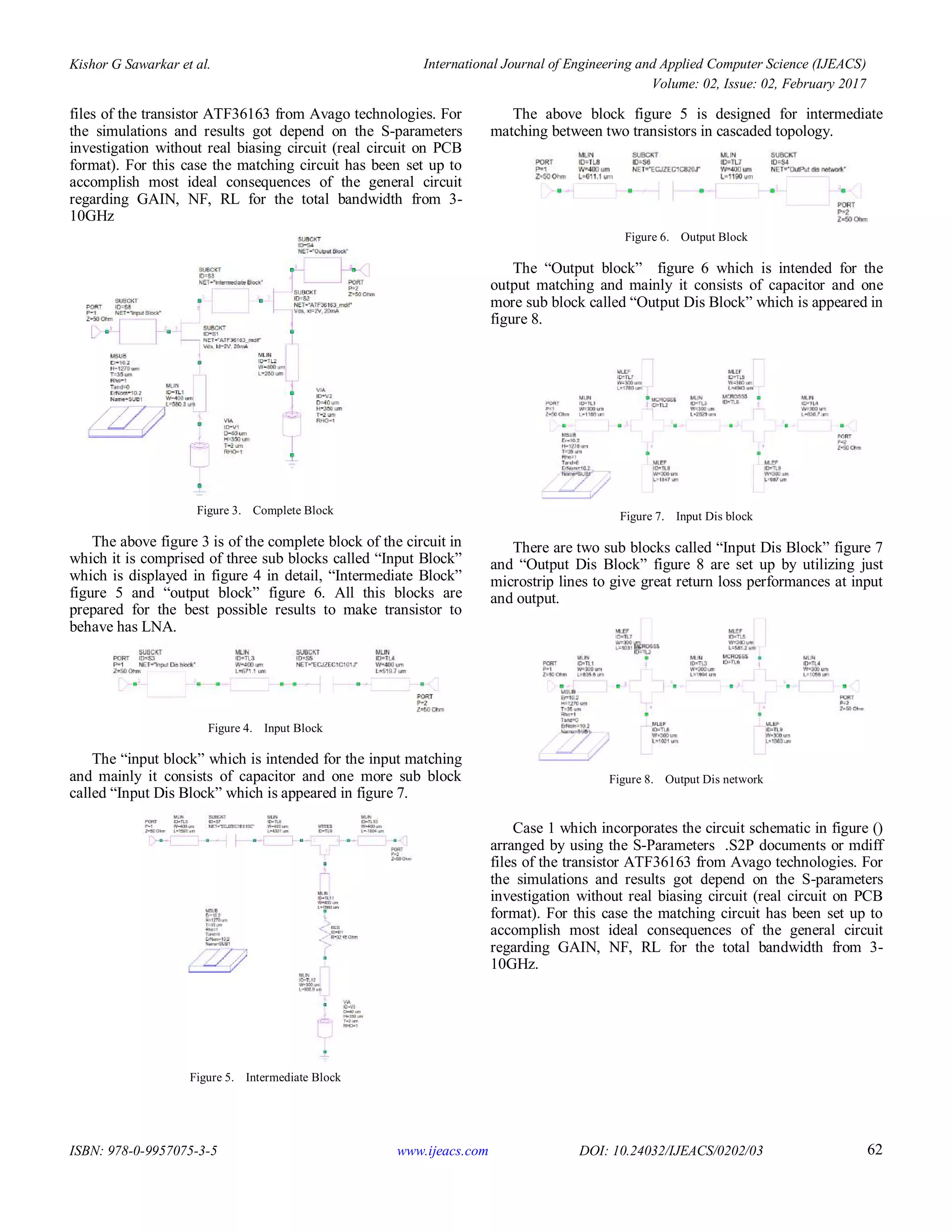
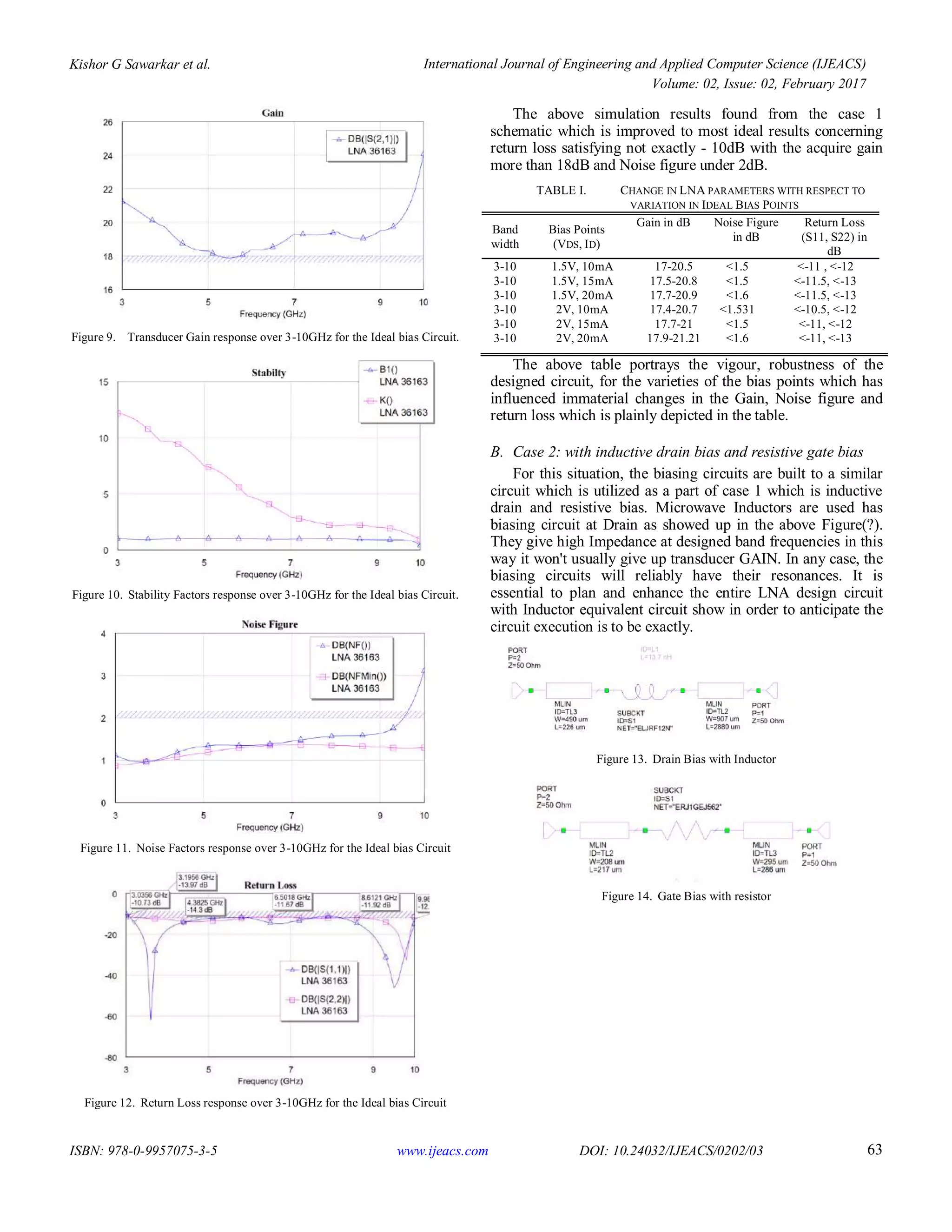
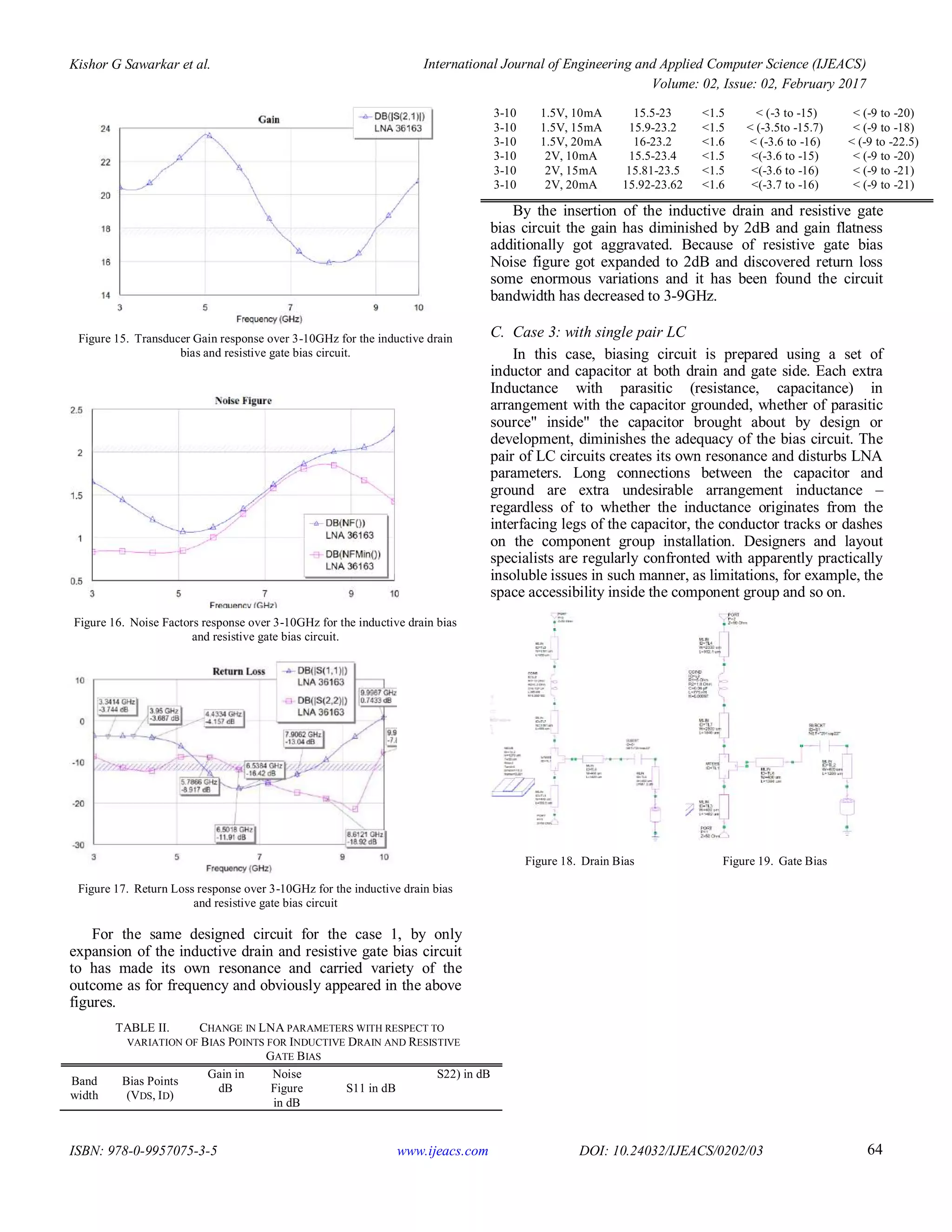
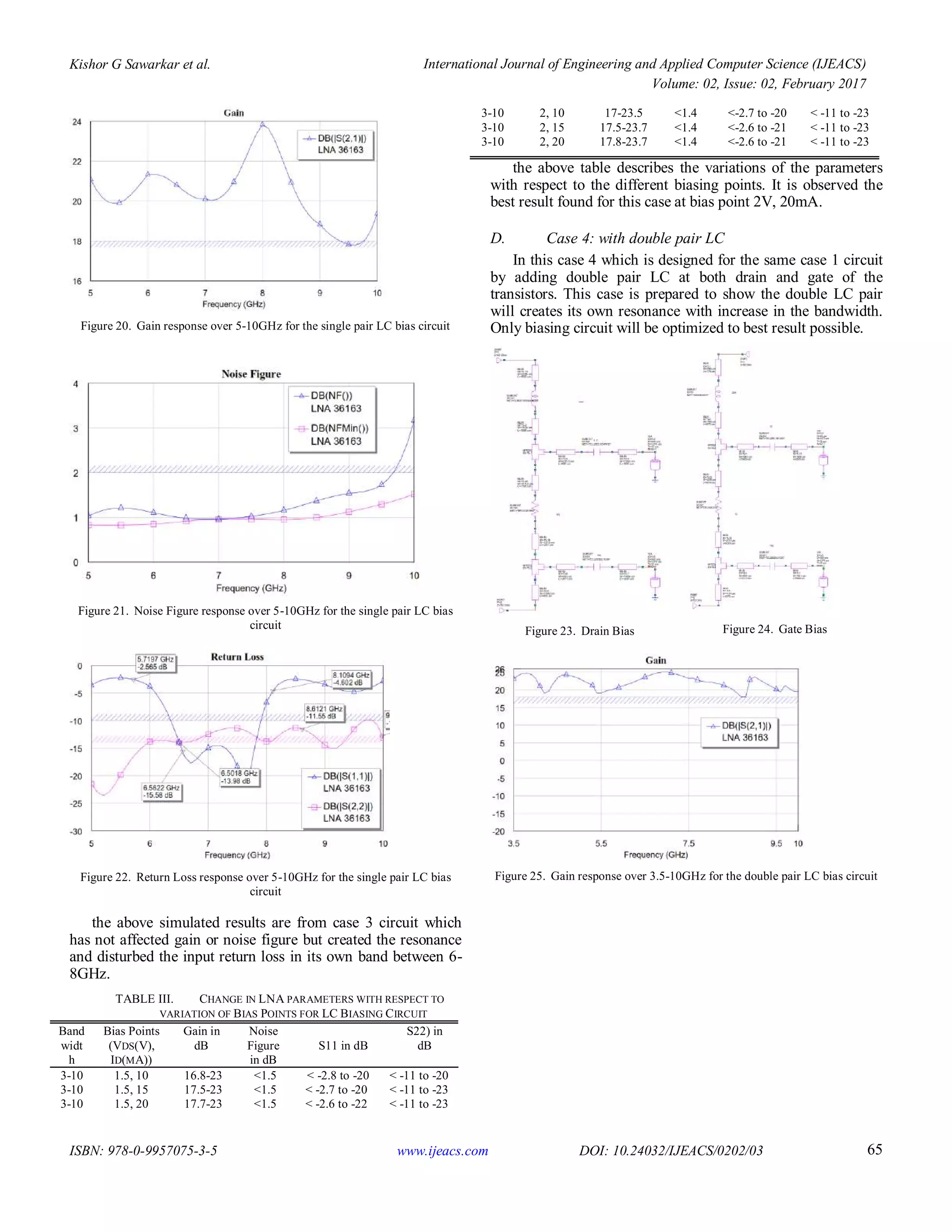
![Kishor G Sawarkar et al. International Journal of Engineering and Applied Computer Science (IJEACS)
Volume: 02, Issue: 02, February 2017
ISBN: 978-0-9957075-3-5 www.ijeacs.com DOI: 10.24032/IJEACS/0202/03 66
Figure 26. Noise Figure response over 3.5-10GHz for the double pair LC bias
circuit
Figure 27. Return Loss response over 3.5-10GHz for the double pair LC bias
circuit
By using double pair LC as biasing circuit has improved
gain and input return loss with minor increase of noise figure.
TABLE IV. CHANGE IN LNA PARAMETERS WITH RESPECT TO
VARIATION OF BIAS POINTS FOR DOUBLE BIASING CIRCUITS
Band
widt
h
Bias Points
(VDS(V),
ID(MA))
Gain in
dB
Noise
Figure
in dB
S11 in dB
S22) in
dB
3-10 1.5, 10 16.8-23 <1.6 < -1.7 to -10 < -9 to -20
3-10 1.5, 15 17.5-23 <1.6 < -1.8 to -10 < -9 to -20
3-10 1.5, 20 17.7-23 <1.6 < -2 to -10 < -9 to -20
3-10 2, 10 17-23.5 <1.6 < -2 to -10 < -9 to -20
3-10 2, 15 17.5-23.7 <1.5 < -2 to -10 < -9 to -20
3-10 2, 20 17.8-23.7 <1.6 < -2 to -10 < -9 to -20
IV. BIASING CIRCUIT EFFECTS ON NON-LINEAR
CHARACTERISTICS
In this section, illustrations and clarifications of LNA
Design Circuit as for biasing Circuit will be given. [15-16] The
effects of Biasing circuit are explained by insertion of single
tone sinusoidal voltage wave (V sin(ωt)) to the non-signal
voltage results in
vgs= VGSQ + V sin(ωt)
vgs will be the function of Vds and Id biasing point of the
transistor which has already been tabulated for the multiple
cases and discussed. Then the harmonic distortion KF is
Where V is maximum amplitude of the signal.
Noted: Distortion Factor approaches to its minimum as
tends to 0
Cross modulation (Intermodulation) produced when two
sine wave signals are amplified at the same time.
vgs= VGSQ + V1 sin(ωt) + V2 sin(ωt) (12)
Since the output current includes the sum and difference
components of the two sinusoidal waves in which
intermodulation results in
√ √
In this case, also it has been clearly examined that distortion
factor decreases as bias is brought closer to =0. These two-
distortion factor will exist in biased circuit which will
deteriorate performance of the designed circuit.
V. SUMMARY
The experimented results of this work can be summarized
as following in the preferences of cases:
Case1: Ideal Bias LNA circuit intended for the best
reasonable estimations of Gain, NF and Bandwidth (3-10GHz)
which is utilized to correlate for the remaining three biasing
strategies likely Drain Inductance and gate resistance bias, LC
bias and double LC bias.
Case 2: Drain Inductance and gate resistance bias is
recommended for the LNA design whose bandwidth is up to
4GHz. The performance in this case linearly Gain decrease
and NF increases and stability will not be affected at any cost.
Case 3: LC bias is suggested for the LNA design for the
smaller bandwidth generally around 2GHz. The LNA
performance with respect to Gain and NF will be great and
results will keep up flatness over small bandwidth.
Case 4: Double LC is proposed for the wideband and ultra-
band with the viable cost on return loss, Gain and NF won't be
highly influenced.
A. Confinement of the Biasing Circuit Design
1) the main cause of the distortion or the variations of the
results with various cases of the biasing circuit is the non-
linearity in the transfer characteristics of the overall circuit with
micro strip line
2) Distortion is also caused by the output conductance gd
related to operating point and drain voltage Vds.](https://image.slidesharecdn.com/the-approach-on-influence-of-biasing-circuit-kishor-g-sawarkar-170301141551/75/The-Approach-on-Influence-of-Biasing-Circuit-in-Wideband-Low-Noise-Amplifier-to-Evaluate-Robustness-Performance-7-2048.jpg)
![Kishor G Sawarkar et al. International Journal of Engineering and Applied Computer Science (IJEACS)
Volume: 02, Issue: 02, February 2017
ISBN: 978-0-9957075-3-5 www.ijeacs.com DOI: 10.24032/IJEACS/0202/03 67
B. Conceivable Solution
1) By applying the feedback to the circuit both distortion
factor and bandwidth can be improved.
2) It is possible to have wideband amplifier with low
distortion factor by initially designing the amplifier for the high
gain and tuning the gain to its optimum level by using
feedback.
VI. CONCLUSION
In this work the effect of biasing circuit on LNA
performance. The effect of three different biasing strategies,
namely; Drain Inductance and gate resistance bias, LC bias and
double LC bias are compared with the ideal bias characteristics
of the LNA design. The parameters in each of these
approached are re-enacted, Simulated and optimized in AWR
microwave office. The importance of the biasing techniques as
far as bandwidth, Noise Figure, Gain and return Loss. Every
case has been breaking down with criticalness of the segments
utilized as a part of analysis in component level of the design
and corresponding impacts on overall circuit have been
introduced. This work is expected to contribute in LNAs for
satellite communications transmissions, Wi-Fi devices and
weather radar systems.
The proposed work given examination, comparison of
different biasing techniques and also clarified with small signal
equivalent circuit model. Moreover, it is obviously presumed
that LNA performances is altogether influenced by the biasing
circuit strategies. The authors are extended their clear
reasonable view and summarized about the effects of different
biasing strategies as for BW, Gain and NF.
ACKNOWLEDGMENT
The authors would like to wish recognize the support for
MCT's Rajiv Gandhi Institute of Technology, Mumbai
furthermore authors want to express gratitude towards Dr.
Udhav Bhosle, Principal of RGIT, for huge support and
consolation for this research work. The authors want to
exceptional a debt of gratitude is in order for Dr. Krishna
Venkatesh, Prof. K. T Srirangaraj, Dr. TGS Moorthy, Prof.
Chandrashekar K. CET, Jain University, Bangalore and Mr.
Manjunatha Reddy H. V General Manager, RF and μW
division, Icon Design Automation Pvt. Ltd. for their significant
guidance and support.
REFERENCES
[1] Michael Steer, “Microwave and RF Design: A Systems Approach,” in
SciTech Pub., 2010 - Technology & Engineering. 952 pages.
[2] David M.Pozar, “Microwave Engineering”, 3Rd Ed in John Wiley &
Sons, 01-Sep-2009 - Microwave circuits - 728 pages.
[3] Reinhold Ludwig, Gene Bogdanov, “RF Circuit Design: Theory and
Applications” in Prentice Hall, 2009 - Technology & Engineering - 704
pages
[4] Joseph J. Carr, “Secrets of RF Circuit Design”, Volume 3, Mcgraw-hill,
11-Dec-2000 - Technology & Engineering - 544 pages.
[5] Nguyen, P. T., Phan, L., Nguyen, Tuan, Tran, Van-Su, . . . P.M., C.
(2015). X-band TR Module for Radar and Wireless Communication
Systems. International Conference on Advanced Technologies for
Communications (ATC) 978-1-4673-8374-5/15/$31.00 ©2015 IEEE,
183-187.
[6] Taryana, Y., Sulaeman, Y., Wahyu, Y., Armi, N., Paramayudha, K., &
Rojak, R. A. (2015). Design of Two Stage Low Noise Amplifier Using
Double Stub Matching Network. IEEE International Conference on
Aerospace Electronics and Remote Sensing Technology (ICARES).
[7] Fernandes, M. D., Oliveira, L. B., & Goes, J. (2016). Wideband noise
cancelling balun LNA with feedback biasing,. IEEE International
Symposium on Circuits and Systems (ISCAS), Montreal, QC, Canada
doi: 10.1109/ISCAS.2016.7527226, 285-288.
[8] Gecan, D., Olavsbråten, M., & Gjertsen, K. M. (2016). Measured
linearity improvement of 10 W GaN HEMT PA with dynamic gate
biasing technique for flat transfer phase. IEEE MTT-S International
Microwave Symposium (IMS), San Francisco, CA, USA doi:
10.1109/MWSYM.2016.7540309, 1-4.
[9] Zhang, D., Ma, H., Yu, H., & Li, J. (2016). Design and on-wafer
measurements of 60GHz MMIC LNA with on-chip active biasing. IEEE
International Workshop on Electromagnetics: Applications and Student
Innovation Competition (iWEM), Nanjing,doi:
10.1109/iWEM.2016.7504894, 1-3.
[10] Ghosh, S., & Srivastava, K. V. (2016). Polarization-Insensitive Single-
and Broadband Switchable Absorber/Reflector and Its Realization Using
a Novel Biasing Technique. IEEE Transactions on Antennas and
Propagation, vol. 64, no. 8, 3665-3670.
[11] Harzheim, T., Heuermann, H., & M. Marso. (2016). An adaptive biasing
method for SRD comb generators. German Microwave Conference
(GeMiC), Bochum doi: 10.1109/GEMIC.2016.7461613, 289-292.
[12] A. Iftikhar et al., "A printed dipole reconfigured with magneto-static
responsive structures that do not require a directly connected biasing
circuit," 2016 IEEE International Symposium on Antennas and
Propagation (APSURSI), Fajardo, 2016, pp. 1057-1058. doi:
10.1109/APS.2016.7696236.
[13] J. M. Dores, E. B. Alvarez, M. A. Martins, J. M. de la Rosa and J. R.
Fernandes, "A comparative study of biasing circuits for an inductorless
wideband Low Noise Amplifier," 2011 IEEE 54th International Midwest
Symposium on Circuits and Systems (MWSCAS), Seoul, 2011, pp. 1-
4.doi: 10.1109/MWSCAS.2011.6026435
[14] Y. S. Noh, D. P. Chang and I. B. Yom, "Ku-band high-power amplifier
MMIC with on-chip gate biasing circuit," in Electronics Letters, vol. 45,
no. 15, pp. 794-795, July 16 2009. doi: 10.1049/el.2009.0251
[15] H. G. Han, D. H. Jung and T. W. Kim, "A 2.88 mW + 9.06 dBm IIP3
Common-Gate LNA With Dual Cross-Coupled Capacitive Feedback," in
IEEE Transactions on Microwave Theory and Techniques, vol. 63, no.
3, pp. 1019-1025, March 2015. doi: 10.1109/TMTT.2014.2377036
[16] H. Lee, T. Chung, H. Seo, I. Choi and B. Kim, "A Wideband Differential
Low-Noise-Amplifier With IM3 Harmonics and Noise Canceling," in
IEEE Microwave and Wireless Components Letters, vol. 25, no. 1, pp.
46-48, Jan. 2015. doi: 10.1109/LMWC.2014.2365733
AUTHORS PROFILE
K. G. Sawarkar is working towards
Ph.D. as Research Scholar at MCT’s
Rajiv Gandhi Institute of technology,
Mumbai University. Currently working
as Head of Electronics &
Telecommunication Engg Dept. RGIT,
Mumbai and. His Area of Interest is
Design of analog circuits, design of RF
circuits and systems He has done his BE
in Electronics under Amravati
University and M.E from Mumbai University.](https://image.slidesharecdn.com/the-approach-on-influence-of-biasing-circuit-kishor-g-sawarkar-170301141551/75/The-Approach-on-Influence-of-Biasing-Circuit-in-Wideband-Low-Noise-Amplifier-to-Evaluate-Robustness-Performance-8-2048.jpg)
